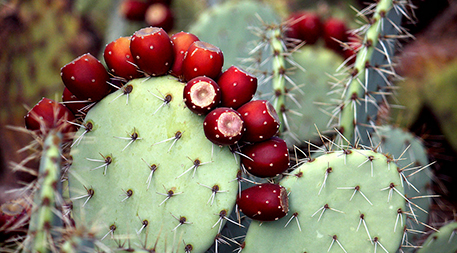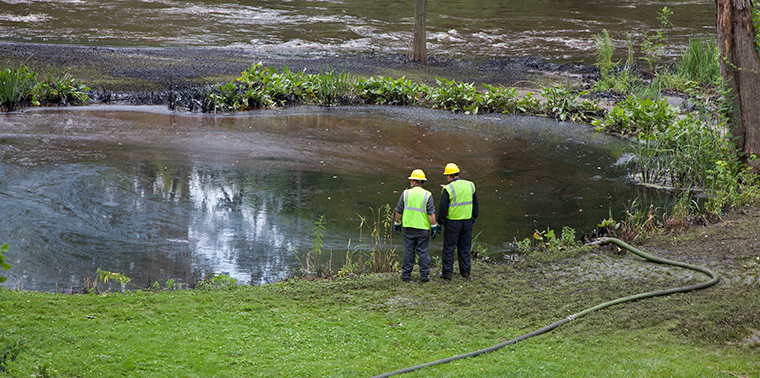June 2, 2014 — It was the day after Christmas, and I stood at the edge of McGrath Lake in Ventura County, just north of Los Angeles. This prime bird habitat is tucked among coastal sand dunes bordering a local surf spot, but I wasn’t there to catch waves. I was a veterinarian who answered a call to help clean up 84,000 gallons of goop leaking from a storage tank pipe into the lake, surrounding wetlands and the Pacific Ocean.
For the next five days I worked alongside volunteers at the county animal shelter — our spill response outpost — cleaning gobs of goo off ducks, coots and other shorebirds. Despite stacks of ventilating fans, the fumes burned even my breath. Of more than 200 birds found, fewer than 50 survived. The rescued birds barely moved, enduring bath after bath with dishwashing soap to get the oil off. Cleaning up their habitat was even harder.
Even with the best tools available, history shows that responders typically collect less than 15 percent of the oil.Twenty years later, the drill after every spill in water, big or small, is the same: contain the oil and then extract, burn or disperse it. But now we know that too much oil gets left behind, seeping into the environment and the food chain. Studies show that dispersants can be toxic, too. Recognizing that despite our best efforts spills will be with us as long as we use oil, scientists are designing better strategies for cleaning them up.
Herding Oil
When slicks happen, responders first deploy booms — floating obstacles — to surround the spill. Next they use skimmers and vacuums, which act like oversized pool tools, to remove the oil. Sometimes slicks are burned away. More often, cleanup crews use chemical “dispersants” to break up the oil into tiny globules that sink beneath the water’s surface. Even with the best tools available, history shows that responders typically collect less than 15 percent of the oil.
Although herders aren’t new, the push for Arctic oil exploration sparked a resurgence of interest. It isn’t easy to corral an oil spill: Waves, wind and ocean currents all conspire to spread oil faster than we can
remove it. So scientists have developed chemical “herders” to round up the oil. Outlining the edges of a spill with these small molecules changes the behavior of the oil droplets, forcing them closer together. The thicker slicks can then be burned.
Although herders aren’t new, the push for Arctic oil exploration sparked a resurgence of interest, says Steve Potter, managing director of SL Ross Environmental Research in Canada, a company that’s done much of the experimental work. Herders can work around chunks of ice — or reedy marshlands — where booms are hard to place. Now scientists are testing these herders in the field.
Super Sponges
Vacuums suck up as much water as they do oil. But AeroClay — hailed as a “super sponge” when it was trademarked six years ago — sucks up only oil. The mix of water-repelling polymers and clay isn’t really a sponge; it’s layers of tiny straws, or capillaries, that draw in oil. Innovators envision booms stuffed with AeroClay being dragged through a spill to absorb oil. Once saturated, the oil can be squeezed out and reclaimed.
“Nothing is left behind,” says Yuxin Wang, polymer engineer for Compadre, LLC, who was a student in the lab at Case Western Reserve University in Ohio that engineered the material. In February, AeroClay was licensed for further development by a Texas-based start-up company.
Prickly Solution
When dispersants break up slicks, the oil doesn’t disappear. Its ill effects climb up the food chain when bacteria and other plankton eat the bite-size droplets. This year, at the Gulf of Mexico Oil Spill and Ecosystem Science Conference, researchers from Temple University in Pennsylvania presented results from a study that found dispersants alone may kill deep sea coral faster than oil or coral treated with oil and dispersant.

Chemical engineer Norma Alcantar is exploring whether an extract from prickly pear cactus could offer a less-toxic alternative to conventional dispersants used in the wake of an oil spill. Photo by cobalt123 (Flickr/Creative Commons).
Could we grow less toxic dispersants? Norma Alcantar, a chemical engineering faculty member at the University of South Florida, thinks so. Years ago her grandmother taught her that the gummy liquid found inside prickly pear cactus can purify water. “It’s a traditional practice in Mexico,” says Alcantar. In water, the mucilage gloms onto bacteria and heavy metals. Alcantar has discovered that it also breaks up oil.
So far, Alcantar has shown that powdered mucilage is as effective as the Corexit dispersant used in the 2010 Deepwater Horizon spill. Next she wants to test the cactus against other types of oil. Persuading oil companies to send samples takes time, and it takes money to rent experimental tank facilities for more testing. But Alcantar is optimistic. In fact, she’s already filed for a patent.
Like it or not, oil spills will be part of our future. Efforts like these to find better ways to minimize the damage they do are key to keeping ecosystems as healthy as possible in the face of disasters yet to come.
![]()
Editor’s note: Elizabeth Devitt produced this article as a participant in the Ensia Mentor Program. Her mentor for the project was Massachusetts environment, science and health journalist Jennifer Weeks.
Related Posts
Ensia shares solutions-focused stories free of charge through our online magazine and partner media. That means audiences around the world have ready access to stories that can — and do — help them shape a better future. If you value our work, please show your support today.
Yes, I'll support Ensia!


